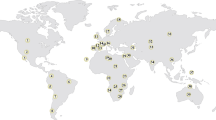Abstract
Polychrome slipped and decorated pottery from Corinth, Greece, developed over two centuries from monochrome, dark brown slips and washes on a calcareous yellow clay body to a wide range of decorative techniques. Once significant experimentation with color variability began, five colors, each with various levels of gloss, were produced. Some slip colors involve multiple-step processing to control glass content and degree of sintering; the control of particle size to produce variable roughness and a matte or semi-matt or glossy appearance. Considerable evidence supports nearly continuous development and engineering of the ceramic slips, although no data support the improvement in composition or processing of the ceramic bodies. For instance, significant macro-porosity consistently is present in the bodies. We present the results of study of 27 sherds with 59 examples of Corinthian polychrome paint layers, measuring 5 to 35 microns in thickness, that were collected by Marie Farnsworth in the late 1950s and 1960s from Greek archaeological sites. Black, red, white, wine red (or purple) and overlying, matte banded slips and paints were studied by optical microscopy, petrographic and scanning-electron microscopy with semi-quantative energy dispersive x-ray analysis, as well as wavelength-dispersive electron microprobe (EPMA) elemental mapping and analysis.
Similar content being viewed by others
References
Cook, Robert M., Greek Painted Pottery, London: Methuen, 1972, p. 42–56.
Mee, C., Greek Archaeology: A Thematic Approach, Chichester, U.K.: Wiley-Blackwell, 2011.
Rasmussen, Thomas, “Corinth and the Orientalising Phenomenon” Looking at Greek Vases, Ed. Tom Rasmussen and Nigel Jonathan Spivey, Cambridge: Cambridge University Press, 1991, p. 58–67.
Robertson, Martin, A History of Greek Art, London: Cambridge University Press, 1975, p. 25– 26, and M. Robertson, The Art of Vase Painting in Classical Antiquity, Cambridge; New York: Cambridge University Press, 1992.
Schaus, Gerald, “The Beginning of Greek Polychrome Painting,” Journal of Hellenic Studies, cviii, 1988, p. 107 – 117.
Boardman, John, “The Orientalizing Style” in J. Boardman, Early Greek Vase Painting: 11th-6th Centuries B.C.: A Handbook, New York: Thames and Hudson, 1998, p. 86–87.
Farnsworth, Marie, “Coloring Agents for Greek Glazes,” American Journal of Archaeology, 67(4), 1963, p. 389–396.
Farnsworth, M. “Corinthian Pottery: Technical Studies,” American Jour. of Archaeology, 74(1), 1970, p. 9–20.
Farnsworth, M., “Greek Pottery: A Mineralogical Study,” Am. Jour. of Arch., 68(3), 1964, p. 221–228.
Williams, Charles, personal communication, July, 1989.
Vandiver, P.B. and C.G. Koehler, “Structure, Processing, Properties, and Style of Corinthian Transport Amphoras,” in Technology and Style, vol. ll, Ceramics and Civilization, ed. W.D. Kingery and E. Lense, Columbus, OH: American Ceramic Society, 1986, p. 173 - 217.
Whitbred, Ian K., “Clays of Corinth: The Study of a Basic Resource for Ceramic Production,” Corinth, 20, 2003, p. 1–13.
Smith, Cyril S., Seventy Two Objects Illustrating the Nature of Discovery, MIT Press, Cambridge, MA, and the Smithsonian Institution Press, Washington, D.C., 1980.
Aloupi-Siotis, E., “Recovery and Revival of Attic Vase Decoration Techniques. What can it offer to archaeological research?” in Papers on The Colors of Clay, The J.P. Getty Publications, 2009
Maniatis, Y., E. Aloupi, and A.D. Stalios, “New Evidence for the Nature of the Attic Black Gloss,” Archaeometry 35(1), 1993, p. 23–34.
Kingery, David, “Attic Pottery Gloss Technology,” Archeomaterials 5(1), 1991, p. 47–54
Binns, Charles F., and A. D. Fraser. “The Genesis of the Greek Black Glaze.” American Journal of Archaeology. 33(1), 1929, p. 1–9.
Bimson, Mavis. “The Technique of Greek Black and Terra Sigillata Red.” The Antiquaries Journal 36(3–4), 1956, p. 200–204.
Vickers, M., “Silver, Copper and Ceramics in Ancient Athens.” In: M.J. Vickers (ed.): Pots & Pans: A Colloquium on Precious Metals and Ceramics in the Muslim, Chinese and Graeco-Roman Worlds, Oxford; Oxford: Oxford University Press for the Board of the Faculty of Oriental Studies University of Oxford, 1985, p. 137–151.
Vickers, M., “The Cultural Context of Ancient Greek Ceramics: An Essay in Skeuomorphism.” In: P.E. McGovern, M.D. Notis & W. Kingery (eds.): Cross-Craft and Cross-Cultural Interactions in Ceramics, Westerville, OH: American Ceramic Society, 1989, p. 45–63.
Jay A. Stephens, “Technical Analysis and Replication of Corinthian Polychrome Slips, 8th to 6th Centuries BCE”, senior thesis, Department of Anthropology, University of Arizona, May 2014, 83 pp.
Author information
Authors and Affiliations
Rights and permissions
About this article
Cite this article
Stephens, J.A., Vandiver, P.B., Hernandez, S.A. et al. The Technological Development of Decorated Corinthian Pottery, 8th to 6th Centuries BCE. MRS Online Proceedings Library 1656, 251–281 (2014). https://doi.org/10.1557/opl.2015.838
Published:
Issue Date:
DOI: https://doi.org/10.1557/opl.2015.838




